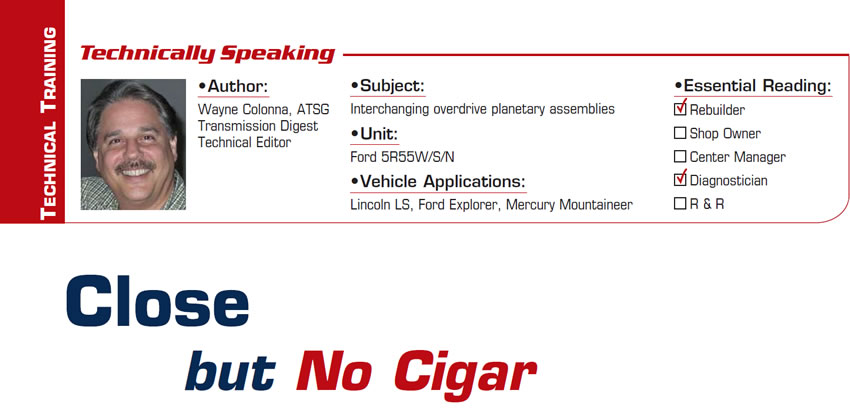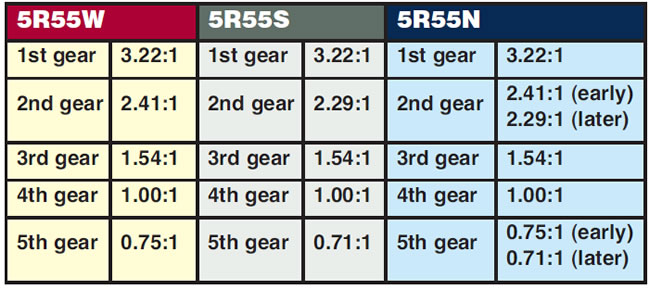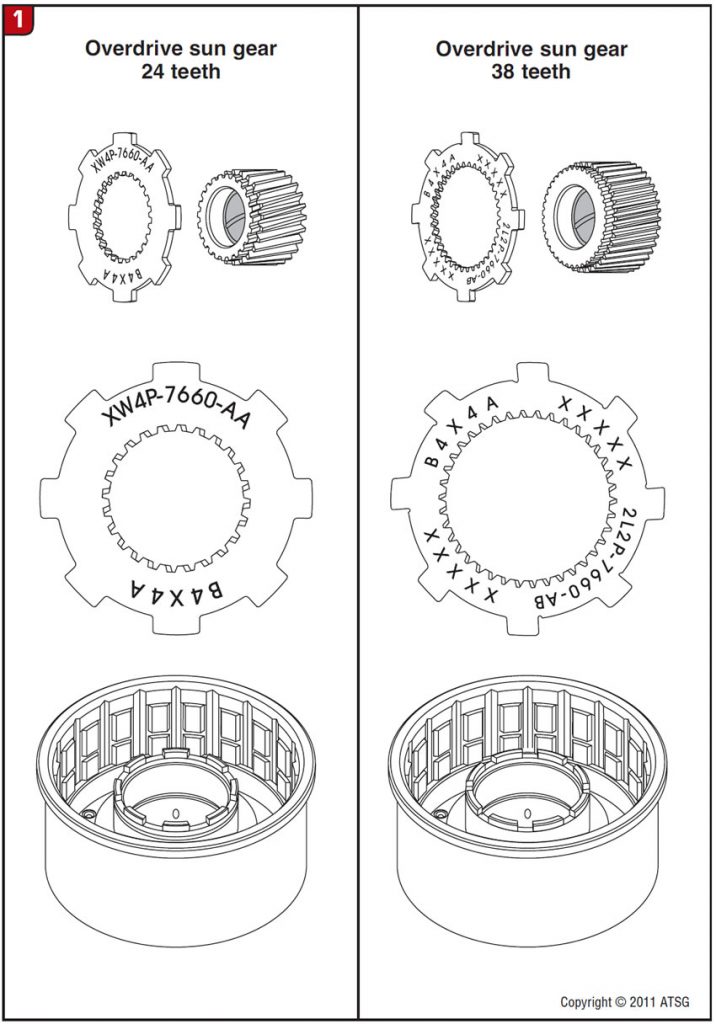
Technically Speaking
- Subject: Interchanging overdrive planetary assemblies
- Unit: Ford 5R55W/S/N
- Vehicle Application: Lincoln LS, Ford Explorer, Mercury Mountaineer
- Essential Reading: Rebuilder, Diagnostician
- Author: Wayne Colonna, ATSG, Transmission Digest Technical Editor
You may have heard the phrase “Close only counts in horse shoes and hand grenades.” Yet at other times you may have heard “Close but no cigar.” Each of these phrases suggests entirely different outcomes.
And such is the case with interchanging overdrive planetary assemblies in 5R55W/S/N series transmissions. When the OD planetary system needs to be replaced, the question that often arises on our technical hotline is: “Are the ratio differences close enough to work?” or “Are the ratio differences between these models significant enough to not work?”
The design of the OD planetary system in these transmissions allows for a 1:1 ratio from the input shaft to the center shaft until the overdrive band comes on and holds the sun gear. When this happens, the input shaft will spin slower than the center shaft.
Ford Motor Co.’s 5R55 W/S & N Transmissions Theory and Operation manual provides the following gear-ratio information:

By looking at these ratios you can see that the main difference occurs in both 2nd and 5th gears. This is when the overdrive band applies, preventing the OD planet from being locked at 1:1 to over-driving at either 0.71:1 or 0.75:1.
There are two different OD planetary assemblies. They are as follows:

To determine which overdrive planetary assembly provides the 0.71 or 0.75 ratio the following calculation can be used:

Interchanging these two assemblies has caused a variety of issues. The Lincoln LS, for example, was originally equipped with a 5R55N and was changed to a 5R55S around 2003. It seems that the computer strategy in the Lincoln has a tight window on ratio tolerance, causing it to be very sensitive to variations. Should OD planets with an incorrect ratio be used, gear-ratio-error codes are produced followed by harsh shifting.
In the cases of Mountaineers and Explorers, they seem to be less sensitive. In fact, anything earlier than 2004 doesn’t seem to be an issue. Starting around 2004 and later we have noticed an increase in the sensitivity of ratio tolerances, which may explain why in some models there are no apparent side effects but in others there are.
What makes these a bit more elusive is that in many instances a harsh or bumpy 1-2 up shift occurs the warmer it gets yet there are no codes. Sometimes it is the 2-3 shift that gets harsh. Downshift clunks and bumps may also be present. Yet, no codes. Sometimes there will be codes and servo bores and valve bodies are blamed yet it’s an incorrect OD planet ratio.

One way to determine whether an incorrect OD planetary ratio has been used is to first erase the keep-alive memory with a scan tool. Then perform the following relearn procedure:
- Install diagnostic equipment and monitor TFT.
- Warm the transmission fluid to 54°C (130°F) as indicated by the TFT.
- Perform five engagements from Park to Reverse five seconds apart.
- Perform five engagements from Drive to Reverse five seconds apart.
- Perform five engagements from Reverse to Drive five seconds apart.
- Perform five engagements from Neutral to Drive five seconds apart.
Now take it out for a road test. If the harsh shifts no longer exist at initial startup but begin to get worse as it is driven, chances are you may have an incorrect OD-ratio set – especially if the servos and valve body have been addressed and you know that the OD planetary was changed.
Usually the 38-tooth sun gear is the most prone to destroying the OD planet set, causing the need for replacement. But if you are not sure what originally was in the vehicle, the most-inexpensive and sure way of knowing is to call the dealer and, with the vehicle’s VIN, order the washer/adapter that splines onto the OD sun gear and locks it to the coast-clutch drum (Figure 1). The basic part number for this piece is 7660. If the washer fits the sun gear you have the correct OD planet system. If it does not, “Close but no Cigar!”

By the way, since we mentioned a couple of colloquialisms we sometimes use in our day-to-day conversations, let me leave you with this. When do you use the phrase “fat chance” and when is it appropriate to use the phrase “slim chance”?

Copyright © 2011 ATSG













